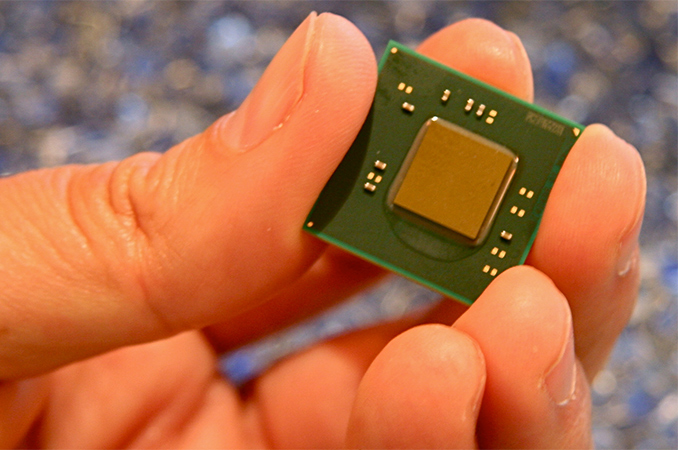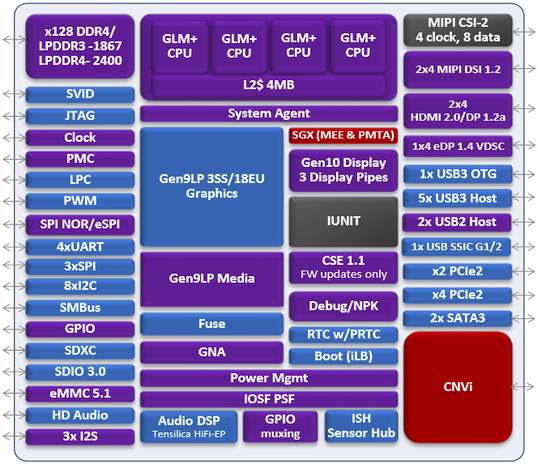IoT Company Discloses Upcoming Gemini Lake SKUs: Two Pentiums, Four Celerons
by Anton Shilov on November 3, 2017 9:00 AM EST- Posted in
- CPUs
- Intel
- Atom
- Pentium
- Celeron
- SoCs
- Gemini Lake
- Pentium Silver

A maker of embedded systems has published details regarding pricing of Windows 10 IoT Enterprise licenses in Q4 2017 and has also disclosed the model numbers of Intel’s upcoming Gemini Lake SoCs. As it appears, Intel is likely to be readying at least six processors, for desktops and laptops, that will be sold under the Celeron and the Pentium Silver trademarks.
According to the table published by Quarta Technologies, a Russian based IoT provider, Intel is set to offer the J5005 and N5000 SKUs for desktops and mobiles (respectively) under the Pentium Silver brand, as well as the Celeron J4005, J4105, N4000 and N4100 models. As with the previous generation Apollo Lake lineup, the list of Gemini Lake shows six SoCs in total: three chips for mobile and three chips for desktop computers. It is not known if this is a final list as of yet.
| Upcoming Gemini Lake SKUs | |||||
| Celeron | Pentium Silver | ||||
| Desktop | J4005 | J4105 | J5005 | ||
| Mobile | N4000 | N4100 | N5000 | ||
Detailed specifications of the processors will be published when Intel finalizes them and publically introduces the entire lineup, but in the interim we can discuss what we know about the new parts. According to CNX-Software, who inspected Linux patches for the new SoCs, the Gemini Lake parts have many similarities with the existing Apollo Lake chips, but also feature a number of tangible improvements in both performance and functionality, CNX-Software also generated a block diagram of the new processors.

from CNX-Software
*The following analysis of unreleased parts is not yet confirmed, but based on Linux patches and Intel's software optimization guidelines
As far as the documents we have suggest, Gemini Lake is set to use revamped Goldmont 'Plus' x86 cores that feature a four-wide issue design, (compared to three-wide in regular Goldmont) accompanied by 4 MB of unified L2 as a last level cache. This alone should improve the performance of the new SoCs, but it is hard to make predictions without knowing the frequencies of the upcoming chips or other microarchitecture changes. The new SoCs are listed as having a 128-bit memory controller that supports DDR4 and LPDDR3/4, although it remains to be seen whether all designs will use all the memory channels. When it comes to graphics, the parts are expected to use the same Gen9LP core with up to 18 EUs as the Apollo Lake (which provides the Direct3D Feature Level 12_1 feature set) and therefore to offer a performance improvement over the predecessor it will have to run at a higher frequency. The integrated should be equipped with an improved multimedia encoding/decoding engine (supporting 10-bit VP9 among other things), and Intel’s Gen10 display controller supporting HDMI 2.0 output. Furthermore, the Gemini Lake is set to support Intel’s SGX that is required by some multimedia applications because of the latest DRM technologies.
When it comes to storage, Gemini Lake should support traditional SATA drives, PCIe 2.0 x2/x4 SSDs, and eMMC 5.1 storage solutions. As for connectivity, the new SoCs should support USB 3.0/2.0, USB Type-C, SPI, SDXC and other modern buses. Furthermore, the chips are likely to feature to the CNVi (Connectivity Integration Architecture) block for Wi-Fi, Bluetooth and baseband modem. Finally, Intel has reportedly updated speed acceleration engine of the Gemini Lake to support dynamic neural networks algorithms.
At present, nothing is known about power consumption of the new Gemini Lake SKUs, but it might be logical to expect them to be comparable to the existing Apollo Lake SoCs (10 W for desktops, 6 W for mobiles).
| Comparison of Intel's Entry-Level PC and Tablet Platforms | |||||||
| AnandTech.com | Bay Trail | Braswell | Cherry Trail | Apollo Lake | Gemini Lake (unconfirmed) |
||
| Microarchitecture | Silvermont | Airmont | Airmont | Goldmont | Goldmont Plus | ||
| SoC Code-Name (Embedded) | Valleyview | Braswell | Cherryview | Apollo Lake | Gemini Lake | ||
| Core Count | Up to 4 | ||||||
| OOOE Architecture | 2-wide | 3-wide | 4-wide | ||||
| Graphics Architecture | Gen 7 | Gen8 | Gen8 | Gen9 | Gen9 | ||
| EU Count | unknown | 16 | 12/16 | 12/18 | 12/18 (?) | ||
| Multimedia Codecs | MPEG-2 MPEG-4 AVC VC-1 WMV9 HEVC (sw) VP9 (sw) |
MPEG-2 MPEG-4 AVC VC-1 WMV9 HEVC (8-bit sw/hybd) VP9 (sw/hybd) |
MPEG-2 MPEG-4 AVC VC-1 WMV9 HEVC VP9 |
MPEG-2 MPEG-4 AVC VC-1 WMV9 HEVC VP9 VP9 10-bit |
|||
| Process Technology | 22 nm | 14 nm | 14 nm | 14 nm | 14 nm | ||
| Launch | Q1 2014 | H1 2015 | 2015 | H2 2016 | H2 2017? | ||
Intel traditionally does not comment on unreleased products, their functionality, and branding. We're expecting Gemini Lake to be launched at some point, but it seems as if the IoT suppliers have sufficient information to start promoting the parts.
Related Reading
- Spreadtrum SC9861G-IA: An Intel Atom Octocore Smartphone SoC on 14nm with LTE
- Intel Launches Atom C3000 SoCs: Up to 16 Cores for NAS, Servers, Vehicles
- Intel Announces Atom E3900 Series - Goldmont for the Internet of Things & More
- Intel Quietly Launches Apollo Lake SoC: Goldmont CPU, 6 SKUs, 6 & 10 Watts
- Intel Unveils New Low-Cost PC Platform: Apollo Lake with 14nm Goldmont Cores
Sources: Quarta Technologies (via FanlessTech), CNX-Software.










15 Comments
View All Comments
guidryp - Friday, November 3, 2017 - link
Now even Atom have 4-wide execution engine. Is there any mainstream CPU that isn't 4-wide.Is it realistic to go 5-wide on a mainstream CPU?
MrSpadge - Friday, November 3, 2017 - link
Mostly only for SMT.tuxRoller - Friday, November 3, 2017 - link
All arm designs (not just arm compatible cores) are 3 wide or less.Samus - Thursday, November 9, 2017 - link
ARM (and most RISC CPU’s) seem to use narrower out of order execution designs because it adds a lot of die area. But as things are getting so ridiculously small now (sub-10nm) caches getting insanely large to the point they are mostly wasted victim caches and the core wars unlikely to stretch into the portables and ultra mobile space (it’s debatable if any programs will need more than 8 simultaneous cores...most don’t even seem to use more than 2) I suspect the improvements are going to be architectural. If SMT comes to ARM, 4 wide OoO will be essential.tuxRoller - Friday, November 3, 2017 - link
So you folks will look at Linux commits to report on unreleased information. Why then don't you do the same for the "black box" adreno cores?CaedenV - Saturday, November 4, 2017 - link
Probably because Intel and AMD news gets the clicks around here.tuxRoller - Monday, November 6, 2017 - link
Fair enough.May I still find it a bit hypocritical when they complain about how they don't know much about the architecture because Qualcomm doesn't release that info?
mode_13h - Saturday, November 4, 2017 - link
Stings a bit that I bought into Apollo Lake, earlier this year. But not *too* bad, since it's still at 14 nm. And probably not as bad as those new owners of i7-7700K's reading announcements of the i7-8700K.r2559324 - Wednesday, November 8, 2017 - link
both apollo lake and gemini lake have HEVC 10bit decoding https://www-ssl.intel.com/content/dam/www/public/u...Mathan kb02 - Thursday, August 20, 2020 - link
Interesting post visit here to know learn more about iot and our services ; https://www.hakunamatatatech.com/our-services/Iot-...